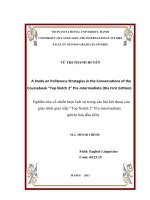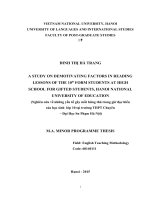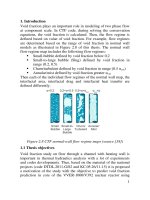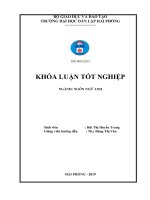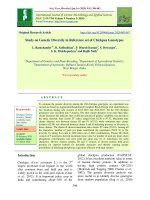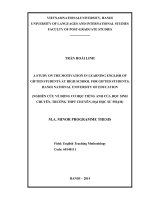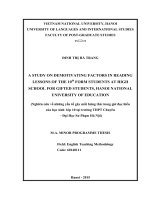Study on sequence variation in rc gene of vietnamese local pigmented rice
Bạn đang xem bản rút gọn của tài liệu. Xem và tải ngay bản đầy đủ của tài liệu tại đây (762.07 KB, 69 trang )
VIETNAM NATIONAL UNIVERSITY OF AGRICULTURE
FACULTY OF BIOTECHNOLOGY
-------oOo-------
GRADUATION THESIS
STUDY ON SEQUENCE VARIATION IN Rc GENE OF
VIETNAMESE LOCAL PIGMENTED RICE
HANOI, 2021
VIETNAM NATIONAL UNIVERSITY OF AGRICULTURE
FACULTY OF BIOTECHNOLOGY
-------oOo-------
GRADUATION THESIS
STUDY ON SEQUENCE VARIATION IN Rc GENE OF
VIETNAMESE LOCAL PIGMENTED RICE
Student
: Nguyen Thi Yen Chi
Class
: K61CNSHE
Faculty
: Biotechnology
Supervisor
: Nguyen Quoc Trung, MSc.
Chu Duc Ha, PhD.
HANOI, 2021
COMMITMENT
This thesis is composed of my original works, and contains no material
previously published or written by another person.
Hanoi, 30th January, 2021
Student
Nguyen Thi Yen Chi
i
ACKNOWLEGEMENTS
During the process of studying, researching and completing the thesis, I
have received the help of many individual
First and foremost, I would like to express my gratitude to my supervisor
MSc. Nguyen Quoc Trung, Department of Biology, Vietnam National
University of Agriculture, and Dr. Chu Duc Ha, Agricultural Genetics Institude,
for their patience, motivation, and immense knowledge. Their enthusiasm
guidance helped me all the time of researching and writing of this thesis.
Besides my supervisors, I would like to thank guides and people working
in Crop Research and Development Institute for sharing their experiences, time,
and commitment during my work to prepare my materials as rice samples.
I also would like to offer all other friends, who also do thesis in Center of
International Plant Research Vietnam and Japan for their kindly help, care and
lift me up all the trouble in the time doing experiments.
My sincere thanks also go to teachers in the Faculty of Biotechnology,
Vietnam National University of Agriculture, whose encouragement, guidance,
and inspiration supported me during my studying time at higher education.
Besides that, I am thankful to my dear classmates, class K61CNSHE, for all the
time we had in the last four years.
Last but not least, I am grateful to my family and my friends for
supporting me spiritually throughout writing this thesis and my life in general
I sincerely thank you!
Hanoi, 30th January,
2021
Student
Nguyen Thi Yen Chi
ii
TABLE OF CONTENTS
COMMITMENT .................................................................................................... i
ACKNOWLEGEMENTS ..................................................................................... ii
TABLE OF CONTENTS.....................................................................................iii
LIST OF TABLES ................................................................................................ v
LIST OF FIGURES ............................................................................................. vi
LIST OF ABBREVIATIONS ............................................................................. vii
ABSTRACT ......................................................................................................... ix
CHAPTER 1. INTRODUCTION ......................................................................... 1
1.1. Introduction .................................................................................................... 1
1.2. Objectives ...................................................................................................... 2
1.3. Requirements ................................................................................................. 3
CHAPTER 2. LITERATURE REVIEW .............................................................. 4
2.1. Evolution and domestication of rice cultivar ................................................. 4
2.2. Overview of theRc gene in rice ..................................................................... 8
2.2.1. Anthocyanin ................................................................................................ 9
2.2.2. Studies on genes controlling anthocyanin synthesis................................. 12
2.2.3. Studies on Rc gene .................................................................................... 16
CHAPTER 3. MATERIAL AND METHODS .................................................. 18
3.1. Materials ..................................................................................................... 18
3.2. Field layout ................................................................................................. 18
3.2.1. Experimental layout .................................................................................. 18
3.2.2. Cultivation techniques .............................................................................. 18
3.2.3. Methodology ............................................................................................. 19
CHAPTER 4. RESULTS AND DISCUSSION ................................................. 24
4.1. Results of cloning and amplification of Rc gene fragments ........................ 24
4.1.1. Design the primers for sequencing ........................................................... 24
4.1.2. Optimization of PCR for cloning fragments............................................. 26
iii
4.2. Results of sequencing Rc gene fragments ................................................... 31
4.3. Alignments of Rc gene ................................................................................. 31
4.3.1. Rc gene in Nep cam dang 2 ...................................................................... 31
4.3.2. Rc gene in Nep cam (Tuyen Quang) ........................................................ 33
4.3.3. Rc gene in Nep cam den ........................................................................... 35
4.3.4. Rc gen in Nep cam (Hoa Binh)................................................................. 36
4.4. Identification of 14 nucleotide deltion in seventh exon .............................. 38
4.5. Sequence variations in Rc gene (SNP) ........................................................ 39
4.6. Phylogenetic tree.......................................................................................... 40
CHAPTER 5. CONCLUSIONS AND SUGGESTIONS ................................... 41
5.1. Conclusion ................................................................................................... 41
5.2. Suggestion .................................................................................................... 41
REFERENTS ...................................................................................................... 42
iv
LIST OF TABLES
Table 1. Example of rice genes involved in flavonoid biosynthesis
(Furukawa et al., 2006) ............................................................................ 13
Table 2. Information of four local pigmented rice varieties used ...................... 18
in this study ......................................................................................................... 18
Table 3. Component of the PCR reation ............................................................. 21
Table 4. The Annealing temperature of each primer .......................................... 21
Table 5. The optimal annealing temperature in PCR for each reasponsible
primers ...................................................................................................... 26
Table 6. Total 17 fragments were sequenced ..................................................... 31
Table 7. Collinear analysis of the seventh exon's partial sequence of Rc gene
for 4 local pigmented rice varieties .......................................................... 39
Table 8. The number of SNP identified by comparising the Nep cam dang 2
variety with 2 varieties ( O. sativa indica and O.sativa japonica) ........... 39
v
LIST OF FIGURES
Figure1. Basic anthocyanin structure ................................................................... 9
Figure2. Two-dimensional structure of flavylium ion........................................ 10
Figure 3. Metabolic pathways for the synthesis of pro‐anthocyanidins and
anthocyanins ....................................................................................................... 11
Figure 4. Rc allele phenotypes (Sweeney, et al., 2006)...................................... 14
Figure 5, 6, 7. The primers were designed locating overlap along Rc gene
sequence .............................................................................................................. 25
Figure 8. PCR product electrophoresis before and after determining the optimal
annealing temperature ......................................................................................... 28
Figure 9,10. Some fragments with single bands ................................................. 29
Figure 11. The product electrophoresis is Rc_8 fragment .................................. 30
Figure 12. Phylogenetic tree of 'Nep cam dang 2' variety .................................. 40
vi
LIST OF ABBREVIATIONS
bHLH
basic helix-loop-helix
BC
Before Century
AD
Anno Domini
QTL
Quantitative trait locus
FNP
Functional nucleotide polymorphism
ABP
Anthocyanins biosynthesis pathway
DFR
Dihydroflavonol‐4‐reductase
PCR
Polymerase chain reaction
vii
LIST OF APPENDIX
Appendix table 1. Sequences of 17 fragments in Nep cam dang 2 .................... 45
Appendix table 2. Sequences of 17 fragments in Nep cam (Tuyen Quang) ...... 48
Appendix table 3. Sequences of 17 fragments in Nep cam den ......................... 51
Appendix table 4. Sequences of 17 fragments in Nep cam (Hoa Binh) ............. 55
viii
ABSTRACT
The aim of study to detect the genetic variations in Rc gene of Vietnamese local
pigmented rice. In this study, we selected 4 rice cultivars, then, sequenced the
full lengths of their Rc genes (approximately 6.4 kb) by a set of 17 pairs of
primers. In addition, we collected 6 different Rc genes in the Oryza genus from
the literature and from NCBI database. Phylogenetic analyses showed that the
Rc genes of Nep cam dang 2 from Yen Bai were rc genotypes found in South
Asia and Southeast Asia.
ix
CHAPTER 1. INTRODUCTION
1.1. Introduction
Rice (Oryza sativa) has been considering as one of the most important
cereal crops that widely cultivated in many regions. Briefly, rice is a staple food
of more than 100 countries as the main carbohydrate source for more than half
of the global population. Depending on the type of rice, it may contain a high
concentration of fibers, proteins, vitamins B, irons, and manganese. Up till now,
a number of rice varieties have been cultivated in the world. Based on the color
of the grain, white rice varieties have been reportedly the most popular cultivars
due to their storable ability and cooking qualities.
Of our interest, some local pigmented rice varieties, including
black/purple rice, brown rice, and red rice have been characterized to have high
nutritional value, especially black rice such as a 1/2 cup serving of prepared
black rice, made from about 1/4 cup of uncooked rice, contains 160 calories, 1
1/2 grams of fat, 34 grams of carbohydrates, 2 grams of fiber, 5 grams of protein,
and 4 percent of iron, carotene, 8 kinds of amino acids and trace elements (iron,
zinc) necessary for the body (Tuoi, et al., 2014). Specifically, the color of the
grain is thought that that the result of the accumulation of flavonoids,
carotenoids, and betalains. In while, flavonoid compounds such as
anthocyanins,
flavonols,
and
proanthocyanidins
are
major
secondary
metabolites in plants and are red, purple (black), and brown in color. However,
little information on pericarp in these rice varieties has been reported.
Rc has been well-characterized as one of the most important regulatory
genes in the pathway of proanthocyanidin accumulation in the rice pericarp(Li,
et al. 2014). Briefly, Rc locates on rice chromosome 7, contains eight exons,
and encodes a basic helix-loop-helix (bHLH) regulatory protein (Furukawa,
Maekawa et al. 2007, Sweeney, Thomson, et al. 2007). The major Rc
domestication allele which has been occurred in more than 97% of non1
pigmented rice cultivars, is characterized by a 14-bp fragment deletion in the
seventh exon (Li, Qiang et al. 2014). This mutation generates a truncated, nonfuctional gene product and the non-pigmented (‘white’) pericarp of the
domesticated rice. An independently evolved domestication allele, Rc-s is found
in other white pericarp rice genotypes with the frequency of less than 3% and
exhibits a base transversion (i.e., C to A) in the seventh exon instead of the
absence of a 14-bp fragment (Sweeney, Thomson, et al. 2007). Furthermore,
“(Brooks, Yan, et al. 2008) identified the spontaneous mutant red pericarp rice
cultivar Wells in the USA, which exhibits one G-base deletion located at the 20bp site upstream of the absent 14-bp fragment in the seventh exon. This new
mutation restores the reading frame and allows the re-accumulation of
proanthocyanidins in the pigmented rice. (Lee, Lupotto, et al. 2009) confirmed
that the red pericarp rice variety Perla Rosso in Italy is a spontaneous mutant
with one G-base deletion at the 44-bp site upstream of the absent 14-bp
fragment in the seventh exon. This new Rc allele is designated as Rcr”(Li,
Qiang et al. 2014). The red pericarp rice cultivated in most African appears a
transversion mutiation (i.e., A to T) occurs in the seventh exon transforms the
pericarp color of African cultivated rice from red to white (Gross, Steffen et al.
2010b). “The allele of Rc is known as rc-g1. So far, six alleles of the Rc gene
have been reported: Rc (wild type); rc and Rc-s, which are domestication alleles
found in Asian cultivated rice; Rc-g and Rcr, revertants of rc; and rc-g1, which
is found only in African cultivars” (Li, Qiang et al. 2014)
The aim of this study was to show the domestication progress of rice in
Vietnam by studying the sequence variation of Rc gene found in local
pigmented rice.
1.2. Objectives
The objectives of this study are to detect sequence variation in Rc gene of
local pigmented rice for rice domestication progress in Vietnam
2
1.3. Requirements
- Design primers for clone fragments of Rc gene in rice
- Optimization of PCR conditions for cloning Rc gene fragments
- Sequencing gene fragments and assemply full sequence of the gene
- Sequence analyzation of Rc gene in 4 varieties
3
CHAPTER 2. LITERATURE REVIEW
2.1. Evolution and domestication of rice cultivar
Rice has been known as the world’s largest food crop, providing the
caloric needs of millions of people daily. Rice belongs to genus Oryza of family
Gramineae that consists of 21 wild-types of the domesticated rice varieties
(Vaughan et al., 2003). The O.sativa genus is divided into four species
complexes, namely O. sativa, O. officialis, O. ridelyi and O. granulata. Firstly,
the O. sativa complex contains two domesticated species, including O.sativa
and O. glaberrima, are the only cultivated species grown worldwide, and in
some parts of West and Central Africa, then, six wild-types, including O.
rufipogon, O. nivara (also considered to be an ecotype of O. rufipogon), O.
barthii, O. longistaminata, O. meridionalis and O. glumaepatulaare fit into O.
sativa complex. O. sativa is distributed globally with a high concentration in
Asia, while O. glaberrima is grown in West Africa. O. rufipogon can be found
throughout Asia and Oceania. Oryza barthii and O. longistaminata are African
species, O. barthii endemic in West Africa and O. longistaminata is found
throughout Africa. Oryza meridionalis is native to Australia and O.
glumaepatula is endemic in Central and South America. Based on these
distributions, it is easy to locate the ancestral pools from which modern rice was
extracted. The African cultivars were domesticated from O. barthii (formally
called O. breviligulata) and O. sativa was domesticated from O. rufipogon
According to Cao et al. 2006, 4000 BC, rice grains sieved from the oldest
known paddy fields in the lower Yangzi River Valley (Cao et al., 2006), giving
clear-cut evidence for rice cultivation at this point in time. Genetic changes
causing the shift from wild to domesticated rice are harder to pinpoint.
Mutations leading to a reduction in the degree of grain shattering are a
prerequisite for domestication. Communities that foraged wild, shattering rice
seeds would likely gather them before maturity since most of the mature grains
4
quickly fall to the ground. Immature rice grains have a smaller width than fully
mature seeds because rice grains reach their full length early in seed
development, and subsequent grain filling increases the width of the seeds. A
survey of diverse modern rices has shown that mature modern cultivated grains
rarely have a width, 2 mm, although some mature wild grains do (Fuller et al.,
2007). Therefore, if width of the assemblage of ancient grains from a site falls
below 2 mm it is unlikely that they represent mature domesticated grains. What
can be documented is that seeds with measurements similar to mature, modern
O. sativa do not appear until 4500 BC at Chengtoushan in the Middle Yangzte
and approx. 4000 BC in the Lower Yangzte area (Fuller et al., 2007). These
seeds are certainly domesticated. Before this time the genetic changes
conditioning a lack of shattering and/or the mutations leading to thicker grains
had not been selected. While these mutations are genetically independent, they
result in the same grain width phenotype.
Rice moved north to the Yellow River basin in Central China beginning
in 3000 – 2000 BC (Crawford, 2005). South of the Yangzi River, work in
Taiwan and Vietnam date the earliest rice finds there to roughly the same time
period, 2500 – 2000 BC (Higham and Lu, 1998). Archaeological work in India
uncovered the Neolithic site Lahuradewa in the Ganges Valley containing evidence
of rice consumption dating to 7000 – 5000 BC (discussed in Fuller, 2006)
As early as the Chinese Han dynasty in China (approx. AD 100) there are
have records of two different types of rice called Hsien and Keng (Matsuo et al.,
1997), as indica and japonica subspecies respectively. There are distinguishing
morphological features, including leaf color, seed size, and apiculus hair length,
but the variation for these traits precludes using them to definitively classify
varieties into subspecies (Kato et al., 1928; Oka, 1988). A third group or
subpopulation was identified based on morphology and was referred to as
5
javanica (Matsuo, 1952). This group is now known as the tropical japonica
subpopulation (Glaszmann, 1987; Garris et al., 2005).
Modern molecular methods have confirmed the ancient observations
about divisions within O. sativa and added new levels of clarity to questions
concerning the origins of rice. According to Wang and Tanksley in 1989, the
indica and japonica subspecies were distinguished by the RFLP studies. In
2005, Garris et al. used SSR marker to examine 169 nuclear loci in 234 diverse
accessions of rice. This work identified five major subpopulations: aus and
indica, grouping within the traditional indica subspecies while the temperate
japonica, tropical japonica, and aromatic subpopulations grouped within the
japonica subspecies.
Many researches have made crosses between O. rufipogon and O. sativa
cultivars looking for genes controlling domestication traits (Xiao et al., 1998;
Xiong et al., 1999; Bres-Patry et al., 2001; Cai and Morishima, 2002; Thomson
et al., 2003; Uga et al., 2003; Li et al., 2006a). These studies have shown that
domestication traits are influenced by many different loci. Several researchers
have noted that QTLs for domestication traits tend to cluster within certain
regions of the rice genome. The centromere region of chromosome 7 is the site
of QTLs for seed color, panicle structure, dormancy, and shattering, among
others (Xiong et al., 1999; Li et al., 2006a). Other clusters for domestication
traits have been reported on rice chromosomes 3, 4, 6, 8, 9, 11, and 12 (Cai and
Morishima, 2002; Li et al., 2006a). This positional convergence may represent
clusters of domestication loci, or possibly major domestication genes with
pleiotropic effects on many traits.
Based
on
the
previously
presented
evidence
of
independent
domestications for indica and japonica, the researchers made some crosses
between the two subspecies, the offspring should segregate for wild alleles at
several loci and wild characteristics should re-appear among sub-specific
6
populations. Most notably for traits like dormancy and shattering, intra-specific
crosses between parents with low dormancy and shattering give rise to progeny
that has higher levels of dormancy and shattering than either parent (Lin et al.,
1998; Miura et al., 2002; Longbiao et al., 2004; Konishi et al., 2006). However,
levels of dormancy and shattering in these crosses are not as high as wild
accessions, suggesting either that indica and japonica share some domestication
alleles or that independent mutations within the same domestication loci
occurred in each subspecies which fail to compliment when crossed. Another
confirmation that different domestication genes were under selection in different
subpopulations comes from QTL studies. Populations derived from crosses
between a single wild accession and diverse cultivars often identity different
QTLs for domestication traits (Xiao et al., 1998; Moncada et al., 2001;
Septiningsih et al., 2003; Thomson et al., 2003; McCouch et al., 2006; Xie et
al., 2006)
A large number of resources currently available to rice researchers, not
the least of which is genome sequence from representatives of both japonica
(Nipponbare) and indica (93 – 11) cultivars (Goff et al., 2002; Yu et al., 2002),
has resulted in an increase in the pace of gene cloning in rice. Recently several
groups have reported the cloning of genes influencing traits associated with
domestication syndrome.
Two of these papers report the cloning of genes affecting shattering. The
first of these papers looked at a cross between the wild species O. nivara and an
indica cultivar (Li et al., 2006b). The sh4 was known as an allele coding nonshattering trait and found several non-shattering accessions of O.nivara.
Besides, the independent mutations in the sh4 locus created functional
nucleotide polymorphism (FNP) and the corresponding haplotypes were
identical in both indica and japonica cultivars. These provided strong evidence
7
for the conclusion that the allele arose once, then crossed the geographic and
genetic barriers for dividing the two subspecies.
The second group to clone a shattering gene worked with a cross between
the aus variety, Kasalath, and the temperate japonica variety, Nipponbare
(Konishi et al., 2006). The mapped QTL, called qSH1 again explained 69 % of
the variation between these two domesticated groups. Within the isoline
carrying the Nipponbare qSH1 allele in a Kasalath background, the lack of
qSH1 gene expression in this tissue results in the complete lack of an abscission
layer. Screening the varieties within temperate japonica showed an association
between this allele and levels of shattering but also demonstrated that selection
for the qSH1 allele was not as intense nor as expansive as selection for the sh4
allele, as qSH1 is not fixed, even within the temperate japonica subpopulation,
let alone the whole of O. sativa.
A third domestication gene that was recently cloned is the Rc gene which
confers a red pericarp (Sweeney et al., 2006). Red pericarp colour is ubiquitous
in wild populations where it confers resistance to various biotic stresses. Early
landraces are red; however, modern cultivars are almost universally white.
Unlike shattering, which is clearly a polygenic trait, only one locus, Rc, has
been reported to affect a change from red pericarp to white. This locus was
positionally cloned from a cross between O. rufipogon and the tropical japonica
variety, Jefferson. Sweeney et al. (2006) identified Rc as a bHLH transcription
factor. The gene’s function is impaired in the Jefferson cultivar by a 14-bp
frame-shift deletion that truncates the protein before the bHLH domain.
2.2. Overview of the Rc gene in rice
Most rice (Oryza sativa) that is grown and consumed throughout the
world has white pericarp, but rice can also produce grains with brown, red, and
purple pericarp. Here, two genes affecting proanthocyanidin synthesis in red
8
and brown‐colored rice were elucidated, were Rc gene and Rd gene. Especially,
Rc is a domestication-related gene required for red pericarp in rice.
2.2.1. Anthocyanin
Anthocyanins are water-soluble vacuolar pigments that, depending on
their pH, may appear red, purple, blue, or black. Food plants rich in
anthocyanins include blueberry, raspberry, black rice, and black soybean,
among many others that are red, blue, purple, or black. Some of the colors of
autumn leaves are derived from anthocyanins.
Anthocyanins are a class of flavonoid pigments synthesised by a
secondary metabolic pathway from the amino acid phenylalanine, and they
impart purple, red and blue coloration in plants. In acidic conditions, anthocyanin
appears as red pigment while blue pigment anthocyanin exists in alkaline
conditions. Anthocyanin is considered as one of the flavonoids although it has a
positive charge at the oxygen atom of the C-ring of basic flavonoid structure. It is
also called the flavylium (2-phenylchromenylium) ion.
Figure1. Basic anthocyanin structure
Anthocyanin is in the form of glycoside while anthocyanidin is known as
the aglycone. Anthocyanidins are grouped into 3-hydroxyanthocyanidins, 39
deoxyanthocyanidins, and O-methylated anthocyanidins, while anthocyanins are
in the forms of anthocyanidin glycosides and acylated anthocyanins. The most
common types of anthocyanidins are cyanidin, delphinidin, pelargonidin,
peonidin, petunidin, and malvidin. Acylated anthocyanins are also detected in
plants besides the typical anthocyanins. Acylated anthocyanin is further divided
into
acrylate
anthocyanin,
coumaroylated
anthocyanin,
caffeoylated
anthocyanin, and malonylated anthocyanin.
Anthocyanin is derived from flavonol, and it has the basic structure of
flavylium ion, which is a lack of ketone oxygen at the 4-position (Figure 3).
The empirical formula for flavylium ion of anthocyanin is C 15 H 11 O+ with a
molecular weight of 207.24724 g/mol. On the other hand, anthocyanins are the
glycosylated form of anthocyanidins. The conjugated bonds of anthocyanins
result in red, blue, and purple-colored plants.
Figure2. Two-dimensional structure of flavylium ion
The anthocyanins biosynthesis pathway (ABP) is one of the most
extensively studied pathways of plant secondary metabolism, produces the
pigments responsible for the coloration of different parts of a plant and most of
the genes that encode the enzymes of this biosynthetic pathway have been
isolated.
10
Figure 3. Metabolic pathways for the synthesis of pro‐anthocyanidins and
anthocyanins
The biosynthetic pathway for each compound is shown, and abbreviations
of enzymes are as follows: ANR, anthocyanidin reductase; ANS, anthocyanidin
synthase; DFR, dihydroflavonol‐4‐reductase; F3H, flavanone‐3‐hydroxylase;
GT, anthocyanidin glucosyltransferase; LAR, leucoanthocyanidin reductase
(cited from Xie and Dixon, 2005)
Pro‐anthocyanidins (colorless polymers found in vivo, which are oxidized
on desiccation to produce the dark‐colored pigments of most seed coats) that are
known as condensed tannins constitute a major subgroup of flavonoids in
plants. Pro‐anthocyanidins accumulate in many different organs of plants and
are either oligomers or polymers of flavan‐3‐ol units. Most proanthocyanidins
are formed from the flavan‐3‐ols, (+)‐catechin‐(2,3‐trans‐flavan‐3‐ol) and
(−)‐epicatechin‐(2,3‐cis‐flavan‐3‐ol). The chemical structure of the linkage
11
between successive monomeric units in proanthocyanidins is known; however,
the enzymatic processes involved in proanthocyanidin formation are still
unknown (Xie and Dixon, 2005). When the anthocyanidins are bonded to a
sugar moiety in the glycosidic linkage, they are knowns as anthocyanins.
The ABP is temporally and spatially regulated by transcription factors
belonging to three main groups of regulatory factors (MYB, MYC (bHLH), and
WD40) that generate the MBW complex required for activating structural genes.
2.2.2. Studies on genes controlling anthocyanin synthesis
Most rice plants have green leaves and white seeds; however, there are
some varieties with purple leaves, purple seeds, red seeds or brown seeds.
Purple
and
red
seeds
contain
anthocyanins
and
proanthocyanidins,
respectively. Coloration by anthocyanins, as well as coloration by compounds
other than anthocyanins, is largely regulated by structural genes and their
regulatory genes.
Several genes involved in anthocyanin coloration of rice have been
extensively studied (Table 1). Two genes, C and A, are involved in the
formation
of
element Pl has
anthocyanin
also
been
pigments.
identified
The
organ‐specific
(Nagao
and
regulatory
Takahashi,
1963). C and A comprise a multiple allelic series of genes: six alleles have been
found at the C locus and four at the A locus. They are ranked in order of
dominance (Nagao et al., 1962). The A1 3. In comparative linkage maps of rice,
the location of the cM on the maize chromosome gene, which encodes the
dihydroflavonol‐4‐reductase (DFR) enzyme, has been mapped at 198 A1 1 (
gene corresponds to the 83‐cM section of the rice chromosome Kinoshita,
1995). The Pl and C 4 and 6 in rice, respectively (
loci are located on
chromosomes Nagao et al., 1957). Molecular cloning of genes involved in
anthocyanin synthesis in rice has been conducted. Those that have been cloned
12
are
the Pl gene
1998; Reddy et al.,
(Chen et al.,
1998; Hu et al.,
1998; Sakamoto et al.,
1996; Nakai et al.,
2001),the C gene
(Saitoh et al.,
2004), and two R genes, Ra1 and Rb (Hu et al., 1996, 2000).
Table 1. Example of rice genes involved in flavonoid biosynthesis
(Furukawa et al., 2006)
Pathway
Anthocyanin
s (Apiculus
and leaf
color)
Genetics study
Nagao and
Takahashi,
1963
Anthocyanin
Kato and
s (Grain
Ishikawa, 1921
color)
Proanthocya
nidins
(Grain
color)
Bagao and
Takahashi,
1947
Chromosome
Gene
locus
Gene by
molecular
cloning
1
A
DFR
6
C
MYB
4
PI
bHLH
unknown
unknown
unknown
A
B
C
7
Rc
bHLB
1
Rd
DFR
Reference
Furukawa
et al., 2006
Saitoh et
al., 2004
Sakamoto
et al., 2001
This study
Sweeney
et al., 200
Furukawa
et al., 2006
With regard to Masuura (1933), and Kato and Ishikawa (1921), the
inheritance of red coloration in the rice seed coat arises from a simple
dominance over white, giving monogenic segregation. They assumed the
presence of three genes, A, B and C, with ABC responsible for red grain
color, ABc responsible for yellowish‐brown grain color, and all other
combinations responsible for white grain color. C is the basic gene for the
production of chromogen, and A exerts its activation effect on C, turning the
13
chromogen into anthocyanin (Table 1) (Kato and Ishikawa, 1921; Masuura,
1933).
Two loci have been identified using classical genetic analysis, Rc (brown
pericarp and seed coat) and Rd (red pericarp and seed coat). When present
together, these loci produce red seed color (Kato and Ishikawa, 1921). Rc in the
absence of Rd produces brown seeds, whereas Rd alone has no phenotype
(Figure 4). There are three known alleles of Rc: Rc, which exhibits brown spots
on a reddish-brown background; Rc-s, which produces a light red color; and rc
(historically, Rc+), which is a null allele. Although Rc is referred to as a mutant
allele because its phenotype differs from that of common rice cultivars, the
action of Rc is dominant over white pericarp (rc). This suggests that the modern
cultivated (white) allele might actually be the mutant (nonfunctional) version of
the ancestral O. rufipogon (red) allele. Both loci have been mapped using
standard two-point analysis on the morphological map of rice: Rc on
chromosome 7 and Rd on chromosome 1.
Top row: seeds from cv Jefferson
B
A
(A) and O. rufipogon (B).
Bottom row: seeds from Surjamkuhi
(C) and H75 (D).
C
D
Figure 4. Rc allele phenotypes (Sweeney, et al., 2006)
14

